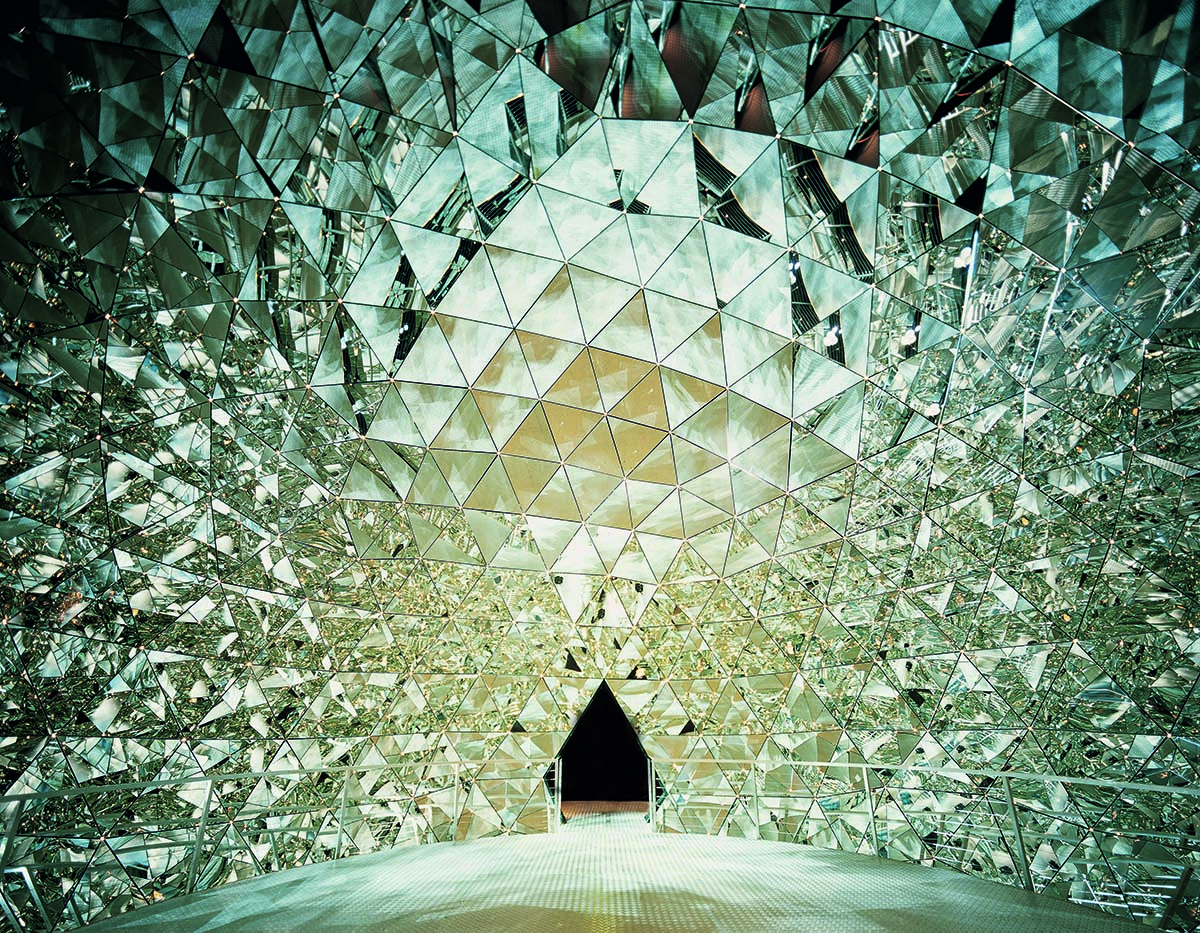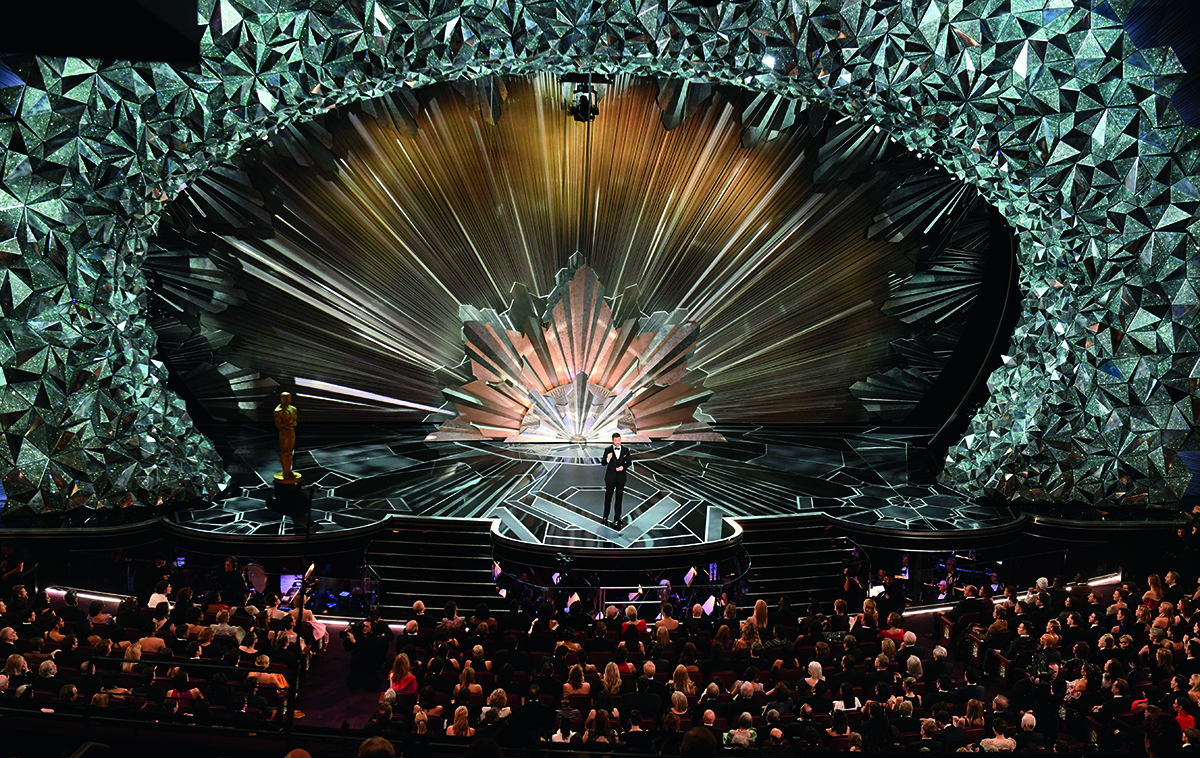
Donatella Versace at spring/summer 2022 Versace show, featuring a backdrop of the brand’s iconic foulards. Image courtesy of Versace
Identifiable by her first name alone, Donatella Versace is unique among designers. The creative director gives LUX the lowdown on what it’s really like being a woman at the top, how she is dipping into the metaverse and why the future of her super-sexy Italian fashion house is all about breaking new ground – and those safety pins. Interview by Fara Bashorun
LUX: How important was it for you to make your own mark on Versace, considering the lack of women designers at the top of the fashion industry?
Donatella Versace: It’s crucial, and I feel responsible – but not just because I am a woman. But because I care. I care that Versace is successful, that my teams are happy. At the beginning it was harder. No one really believed in me. They have always seen me behind the scenes and I was happy to keep doing what I was doing. But then, you know, I didn’t really have a choice – and to give up has never been an option. Because I was a woman – and my surname didn’t matter – I had to work harder than anyone to prove that I was capable. That’s why I think that the change must start from us.
In fact, today, within Versace, women represent 64 per cent of the employees; and 48 per cent of those are executives. Regardless of all the progress that’s been made, women still have to prove themselves more than men have to; women have to fight harder to have their voices heard. I think there is still a problem of credibility when it comes to women in positions of authority: it is still hard for them to have their opinions and actions validated by others. I say this from my own experience. As said, I was the only woman at the helm of the company. It took me a long time to really be heard, trusted and recognised as being capable within my own company.

Image Courtesy of Versace
LUX: “If you want to be comfortable, stay at home in your pyjamas.” You made this statement in 2011: do you still stand by it, despite the shift towards casual luxury?
DV: I think that the most important thing is to be, and express, yourself by wearing whatever you want to. In particular, nowadays, after two years of the pandemic, with social distancing and working from home, the way we dress has changed a lot. And fashion can only adapt to this change. Think of street style and how impactful that was on fashion.
Follow LUX on Instagram: luxthemagazine
Glamour, like style, just has different characteristics according to the times. For example, I have been wearing heels every day to go to the office since the day the total lockdown in Italy was lifted. It feels good. High heels are the quintessential symbol of femininity, a tool for women to feel stronger. The minute we wear them we walk in a different manner, we feel taller, we feel different, we can be whoever we want to be. That is the meaning of fashion anyway. It’s not just about covering ourselves in something warm, but wearing an armour that allows us to express ourselves without fear.

Image courtesy of Versace
LUX: The spring/summer 2022 collection is a confluence of legacy and futurity – iconic foulards, the return of those safety pins… Does this signal a new vision for the brand?
DV: The main inspiration behind the spring/ summer 2022 collection is the iconic Versace silk foulard. It is a fundamental component of Versace’s heritage and DNA. The foulard has been with us since the very beginning of the brand, but for SS22 it turns everything on its head – it is no longer fluid or dreamy, the scarf is provocative, sexy, wound tight for both men and women.
I’ve noticed that there is a fascination for the fashion of the past in the younger generations. They are discovering older treasures, since for them a lot of the fashion from the 1980s and ’90s is new. That’s why I keep bringing the codes of Versace into the world of today, remaining authentic to what they are, but never in an obvious way. There is a story to tell, and I see that people are interested in that story. Versace is always true to its DNA, but at the same time not a slave to it. It keeps on changing and evolving, because I listen to what people want and desire.
LUX: How have you adjusted to working under the ownership of Capri Holdings? Do you still feel that you are in charge?
DV: What has changed is the fact that, being part of a group with larger resources, Versace can tap into them and invest in technology, manufacturing, a larger base of employees. We’re opening new stores. Ultimately, Versace is growing to the next level. Thanks to Capri, I see big opportunities in accessories for sure, but every part of the business is growing.

Image courtesy of Versace
LUX: How important are brand collaborations, such as Fendace (Fendi x Versace)?
DV: As a designer, it gave me the opportunity to use my creativity on something new. It was also a way to create unity, and a sense that fashion houses can work together to offer people something unexpected. It doesn’t matter how designers decide to achieve this goal, but that the creative conversation goes above and beyond one’s own four walls, so to speak. There have been a lot of collaborations, but never a complete swap of designers.
Read more: Durjoy Bangladesh Foundation: Bridging Global South And North
I became the designer of Fendi and they [creative leads Kim Jones and Silvia Venturini-Fendi] became the designers of Versace. I did Fendi how I see Fendi. We saw it like a game, and that allowed us to be free to express ourselves. It’s never happened before. I’d like to underline that a collaboration is one thing, but swapping designers is a totally different thing. They trusted me enough to give Fendi to me and to translate it into my vision. I trusted them enough to hand over Versace.

The new Versace women’s SS22 campaign, featuring Donatella flanked by supermodel sisters Bella and Gigi Hadid
LUX: You once described London as being the heart of new design, rather than Paris or Milan. Why do you think that is?
DV: Because of its energy, its ability to reinvent itself and to be unconventional! It is always new, always fresh. London is one of my favourite cities in the world!
LUX: As fashion brands begin to explore the metaverse, what’s Versace’s take on it? How important is it to you?
DV: I think the metaverse must be explored. My team and I are still learning about this universal virtual world, but I’m happy to embrace new ideas if they fit Versace. I’m fascinated by technology and I love to get to know all the newest and coolest experiences. For example, in 2020, we joined ComplexLand, a digital interactive experience, a first-of-its-kind immersive virtual destination featuring fashion, art, musical performances and cultural conversations. It was my first time as a virtual identity and I found it super modern, and absolutely in line with the brand’s aesthetic and current approach. It was fun to develop my virtual alter ego!
This article appears in the Summer 2022 issue of LUX


















Recent Comments